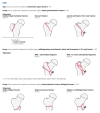Management of Trochanteric Fractures: Are We NICE Compliant?
- PMID: 37965388
- PMCID: PMC10643018
- DOI: 10.7759/cureus.47038
Management of Trochanteric Fractures: Are We NICE Compliant?
Abstract
Introduction: The National Institute for Health and Care Excellence (NICE) updated the 2011 hip fracture management guidelines on January 6, 2023, suggesting that clinicians offer sliding hip screws in preference to intramedullary nails for trochanteric fractures above and including the lesser trochanter except reverse oblique fractures. This study aims to assess the compliance of our hospital with the updated guidelines while comparing the results with our performance prior to the update together with the national average.
Materials and methods: A retrospective observational study was done to analyse if trochanteric fractures managed surgically were compliant with NICE guidelines. Pathological fractures secondary to tumours and AO/OTA 31A1.1 fractures were excluded. Fractures were classified using the 2018 AO/OTA classification system independently by two authors, with a review from a senior consultant if there was interobserver variation. Group A (n=60) included trochanteric fractures managed surgically three months prior to the update, while Group B (n=46) included patients managed operatively three months following the update.
Results: The compliance rates for Group A and Group B were similar at 88.33% and 89.13%, respectively, while the national average was about 67% over the course of six months.
Discussion: 31A2 fractures showed higher rates of non-compliance in both groups. Non-compliance was thought to be multifactorial: surgeon bias, inaccurate classification of fractures and a lack of awareness of guidelines.
Conclusions: While there is scope for improvement, district general hospitals can achieve high rates of compliance. Educating and training doctors could help improve compliance.
Keywords: extracapsular hip fracture; hip fracture; intramedullary nail; nice guidelines; sliding hip screw; trochanteric fractures.
Copyright © 2023, Kumar et al.
Conflict of interest statement
The authors have declared that no competing interests exist.
Figures


References
-
- Improving Understanding - The National Hip Fracture Database Report on 2021. [ Sep; 2023 ]. 2022. https://www.nhfd.co.uk/FFFAP/Reports.nsf/0/EA5D572779948D14802588D8005C1... https://www.nhfd.co.uk/FFFAP/Reports.nsf/0/EA5D572779948D14802588D8005C1...
-
- National Hip Fracture Database Annual Report 2018. [ Sep; 2023 ]. 2018. https://www.nhfd.co.uk/files/2018ReportFiles/NHFD-2018-Annual-Report-v10... https://www.nhfd.co.uk/files/2018ReportFiles/NHFD-2018-Annual-Report-v10...
-
- Projected incidence of proximal femoral fracture in England: a report from the NHS Hip Fracture Anaesthesia Network (HIPFAN) White SM, Griffiths R. Injury. 2011;42:1230–1233. - PubMed
-
- Hip Fracture: Management. [ Sep; 2023 ]. 2023. https://www.nice.org.uk/guidance/cg124/resources/hip-fracture-management... https://www.nice.org.uk/guidance/cg124/resources/hip-fracture-management...
LinkOut - more resources
Full Text Sources
